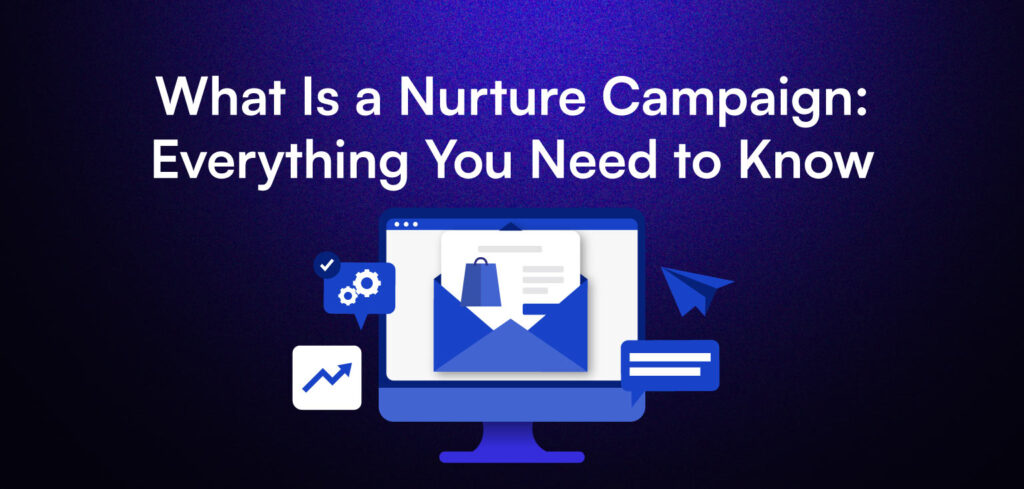You’re missing out if you’re sending the same email to every subscriber. Email marketing isn’t just about broadcasts and flash sales. It’s about building relationships, especially with leads who aren’t quite ready to buy.
That’s where the question “What Is a Nurture Campaign” comes in.
Instead of pushing the sale too early, nurture campaigns help you stay relevant, add value, and show up at the right moment.
And the best part?
You can automate most of it, freeing up time while building real trust with your audience.
In this blog, we’ll break down what a nurture campaign is, why it works, and how you can build one that converts.
What Is a Nurture Campaign?
A nurture campaign is a series of emails sent automatically to guide someone through their journey with your brand, from curious browser to loyal customer.
Think of it like a helpful tour guide. Instead of dumping all the information or offers at once, it checks in at the right moments with helpful content, answers, and nudges, based on where someone is in their decision-making process.
How It Differs from Promo Emails or Newsletters
Promo emails usually scream, “Buy now!” and newsletters tend to say, “Here’s what’s new.”
But a nurture campaign says, “Here’s something helpful, just when you need it.”
While promotions and newsletters go to your whole list, nurture campaigns are usually triggered by an action, like downloading a free guide, abandoning a cart, or signing up for a product demo.
Because they’re behaviour-based, they feel more relevant and less like spam.
Why Timing and Context Matter
Let’s say someone just joined your email list.
You wouldn’t send them a 30% off coupon for your loyalty program yet, they barely know your brand. That’s like asking someone to commit on the first date.
With a nurture campaign, you can space things out:
- Start with a warm welcome
- Introduce your products or services
- Share useful content
- Then ask for the sale when the time feels right
The right message at the right time makes all the difference. Nurture campaigns help you build trust and stay top of mind without being pushy.
Why Nurture Campaigns Are Essential for Email Marketing
You can’t convert everyone right away, and that’s okay.
But if you don’t follow up?
You’ll lose people who were almost ready to buy.
That’s where nurture campaigns do the heavy lifting. They bridge the gap between interest and action, especially when someone isn’t ready to make a decision yet.
Here’s why they work so well:
- For leads: They offer helpful info, tips, and reassurance before asking for anything in return.
- For new customers: They help with onboarding, answer FAQs, and prevent buyer’s remorse.
- For long-term loyalty: They keep your brand in the conversation, so you’re not forgotten between purchases.
Instead of blasting one-size-fits-all promos, nurture campaigns deliver the kind of experience customers want to receive: relevant, timely, and useful.
And when that happens?
You see better open rates, more clicks, stronger brand trust, and ultimately, higher conversions.
Key Elements of a Successful Nurture Campaign
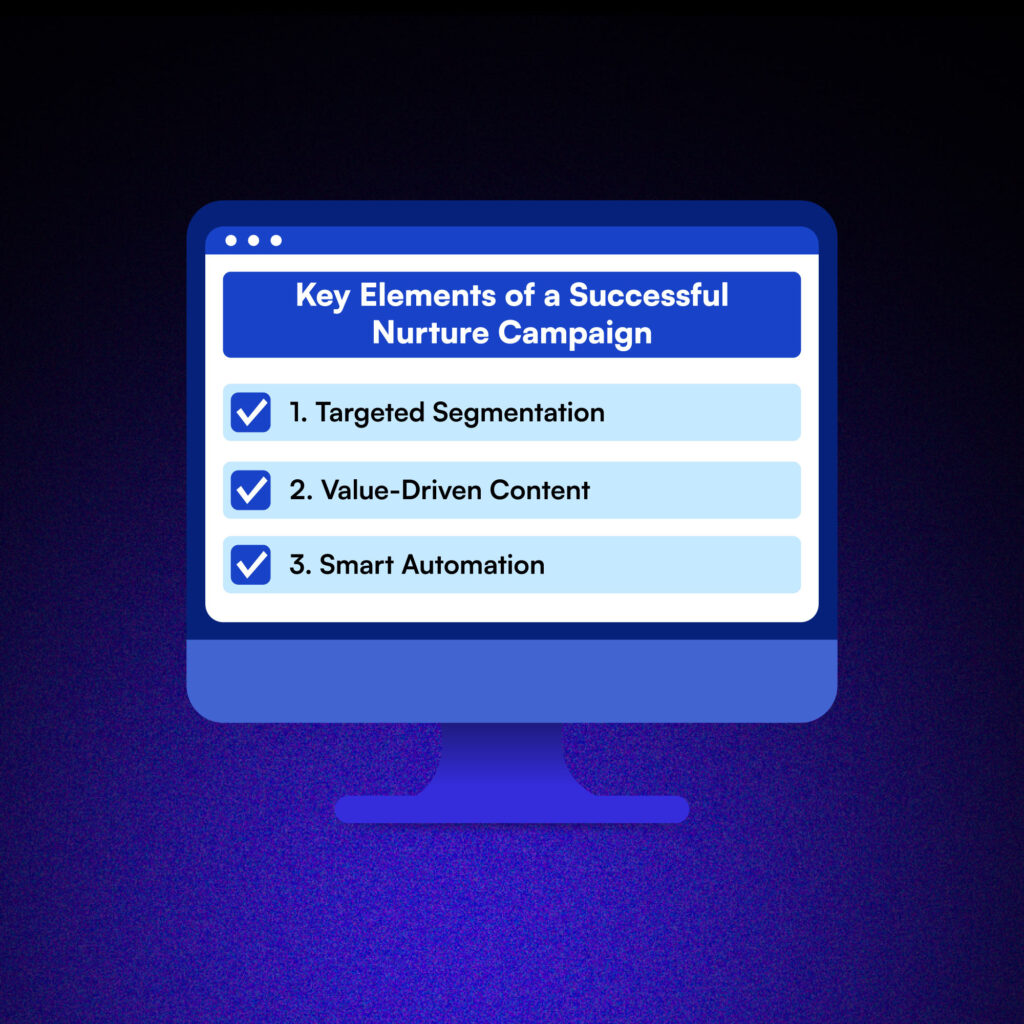
Not all nurture campaigns work the same way, but the best ones share a few core ingredients.
Here’s what to get right:
1. Targeted Segmentation
Before you send anything, you need to know who you’re talking to. Segmentation is how you group your audience based on their behaviors or characteristics, so you can send emails that actually feel relevant.
- New subscribers vs. returning customers – New folks need education and trust-building; returning ones want recognition and value.
- People who downloaded a guide vs. those who abandoned a cart – One group is curious, the other showed clear intent. You don’t talk to them the same way.
- High spenders vs. one-time buyers – VIPS might deserve exclusive perks, while newer customers might need a push toward that second purchase.
The more tailored your message, the more likely it is to land.
2. Value-Driven Content
This is where most brands go wrong, they jump into selling too fast. A nurture campaign should feel more like a helpful friend than a pushy salesperson.
Your emails should aim to:
- Answer common questions – What do people usually wonder about your product or service? Address that.
- Solve a small problem – Provide a tip or shortcut that makes their life a bit easier.
- Share tips, guides, or insights – Give content that helps your audience get better at something they care about.
- Tell stories your audience relates to – Testimonials or case studies make your brand feel more human and trustworthy.
Give before you ask, build trust first, then convert.
3. Smart Automation
Good nurture campaigns run on autopilot, but they don’t feel robotic.
- Trigger emails based on behavior – Like signing up for a freebie, viewing a product, or clicking a link.
- Space them out naturally – You don’t want to send five emails in two days and scare people off.
- Review your flows regularly – Customer behavior changes, and your emails should evolve too.
Tools like Klaviyo or HubSpot make this easy, even if you’re not tech-savvy.
Examples of Nurture Campaigns That Work
Need a few concrete ideas? Here are some go-to nurture campaigns that consistently deliver results:
Lead Magnet Follow-Up
Let’s say someone downloads your free guide or signs up for a quiz. Don’t leave them hanging.
Follow up with a short email series that:
- Expands on the content – Give them even more value related to what they just downloaded.
- Shares additional resources – Direct them to your blog, case studies, or product pages.
- Introduces your product as the next step – But do it subtly, so it feels like a natural solution.
Welcome / Onboarding Series
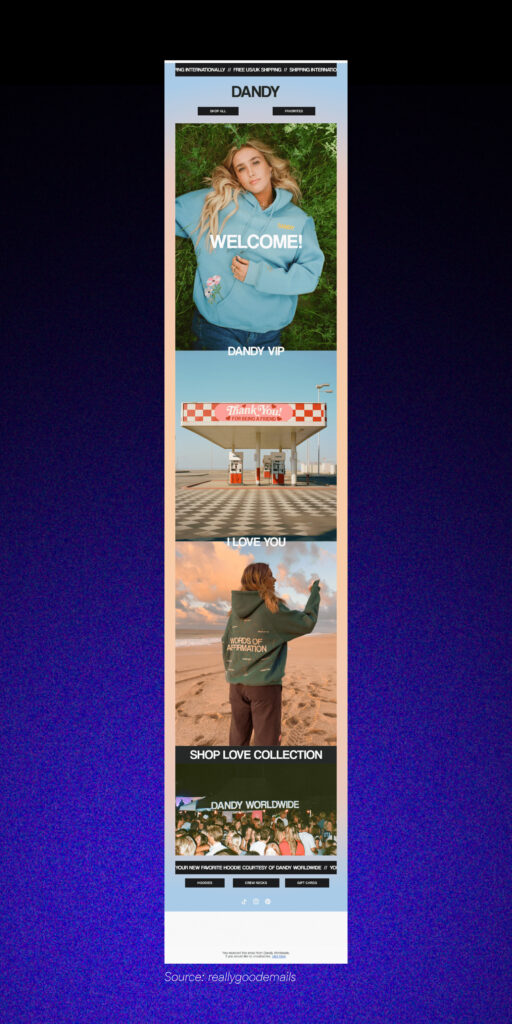
This is your first impression, and it sets the tone for your relationship.
- Say thanks and set expectations – Tell them what kind of emails you’ll be sending and how often.
- Introduce your brand’s values or best-sellers – Let them know who you are and what makes you different.
- Offer a small win – Like a tip, quick how-to, or even a discount to get them excited about engaging.
Abandonment Recovery
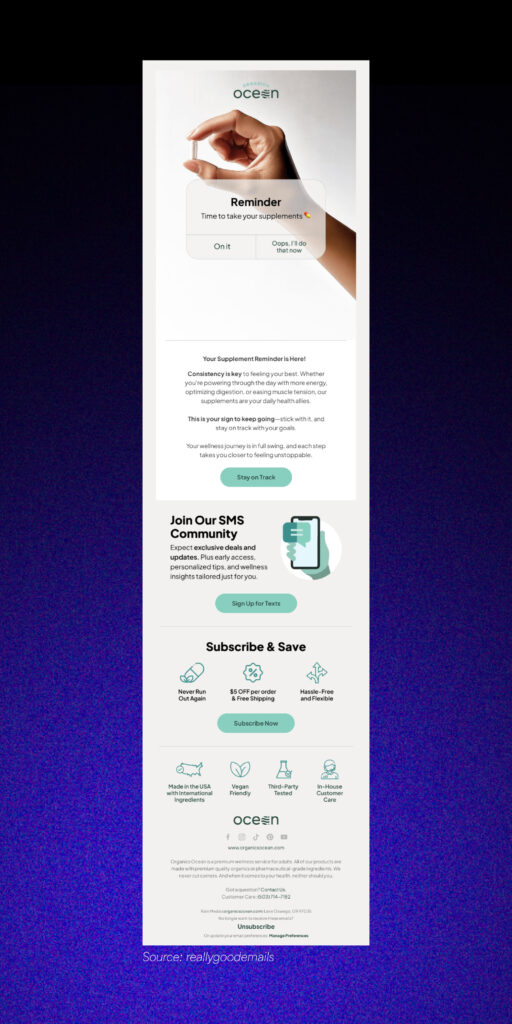
When someone browses or adds to cart but doesn’t buy, don’t just remind them. Nurture them.
- Email 1: A gentle reminder with product details – “Hey, we saved this for you.”
- Email 2: A benefit-driven message – Focus on why the product is worth buying.
- Email 3: Maybe a limited-time offer – If it fits your brand, use urgency to nudge them.
Post-Purchase Education
The sale isn’t the finish line, it’s the start of the relationship.
- Use or get the most out of their purchase – Help them use it well, so they feel confident.
- Discover complementary products – Suggest useful add-ons, not random upsells.
- Know they made a great choice – Reinforce their decision to buy from you.
Instead of pushing for another sale, Organics Ocean gently guide the customer back into their routine with a well-timed nudge. The design is clean, the message is personal, and it’s all about helping the user succeed with what they’ve already started.
Apply the same principle in abandonment flows, be helpful, not pushy.
How to Build a Nurture Campaign (Step-by-Step)
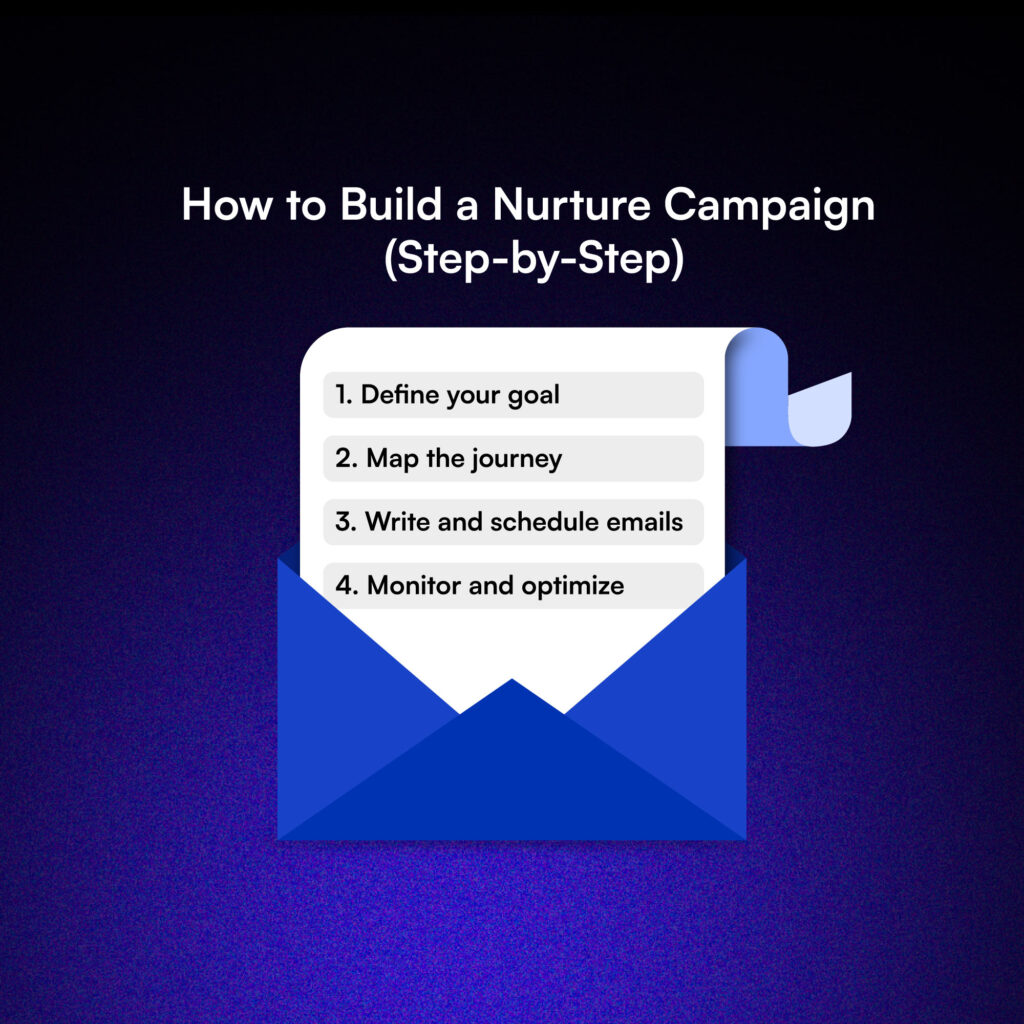
You’ve got the theory, now here’s how to build a nurture campaign from scratch. It doesn’t need to be complicated, just clear and intentional.
1. Define your goal
Start with the why. Every nurture campaign should have one clear objective.
Are you trying to:
- Turn leads into customers? These are people who showed interest but haven’t bought yet. You’ll need to build trust and educate them.
- Onboard new users? Help them get started with your product or service so they don’t lose momentum or interest.
- Encourage repeat purchases? Reconnect with buyers post-purchase to bring them back again with value or new offers.
- Re-engage inactive subscribers? These are people who haven’t opened or clicked in a while. Remind them what they’re missing.
Knowing the goal helps you write better emails, measure success, and avoid sending fluff.
Example: If your goal is to turn free trial users into paying customers, your emails should educate, build trust, and highlight the product’s value fast.
2. Map the journey
Now think about the path your subscriber takes from start to finish.
Ask:
- What action triggers this campaign? For example, did they download a guide, sign up for a webinar, or make a first purchase? That’s your starting point.
- What should happen next, and in what order? Think about the logical next steps and what kind of messages help move them forward.
- How many emails do you need to get them from point A to point B? Too few, and you’ll lose momentum. Too many, and it’ll feel like spam. Aim for balance.
Outline each touchpoint and decide what content fits best at each stage: awareness, consideration, or decision.
Tip: Keep spacing natural. 2–3 days between emails is often a sweet spot for nurture flows.
3. Write and schedule emails
Time to bring it to life. Each email should serve a purpose, build trust, educate, nudge, or invite action.
Structure your emails around:
- A clear subject line – Use something helpful or curiosity-driven. Think: “3 Mistakes Most [Industry] Buyers Make” instead of “Newsletter #6.”
- A single goal per email – Focus each email on one idea: a tip, a case study, a product feature. Don’t overload the reader.
- A CTA that matches your stage – This could be “Learn more,” “Read the guide,” or “Shop now,” depending on where they are in the journey.
Once written, use your platform (like Klaviyo or HubSpot) to schedule your sequence based on behavior triggers.
Bonus: Preview your full flow in your email tool’s visual builder. It helps you spot gaps or awkward timing.
4. Monitor and optimize
Even great campaigns can get better.
After your nurture sequence is live, keep an eye on:
- Open and click-through rates – This tells you if people are interested in your subject lines and content.
- Unsubscribes or spam complaints – High numbers here mean something’s off, maybe your tone, timing, or targeting.
- Which emails drive action (and which fall flat) – Look for the emails that get people to click, buy, or reply—and double down on what works.
Then tweak. Swap subject lines. Test send times. Cut or combine emails. Your first version is rarely your final version, and that’s okay.
Pro tip: Revisit your nurture flows quarterly to keep them fresh and relevant.
Common Mistakes and How to Avoid Them
Even the most well-meaning brands can trip up when running a nurture campaign. These are the top missteps we see, and how you can sidestep them.
- Sending too much, too soon: You want to stay visible, but blasting your subscribers with emails every day is a quick way to annoy them. Instead of feeling nurtured, your audience feels spammed. When that happens, engagement drops, or worse, they unsubscribe.
Fix it: Let your emails breathe. Send one every 2–3 days to give people time to open, read, and act. Quality over quantity keeps your brand welcome in their inbox.
- Being overly promotional: If your nurture campaign sounds like a string of sales pitches, you’re doing it wrong. People don’t sign up just to be sold to, they want to feel like they’re getting value. If every email is a discount code, your messages lose meaning (and impact).
Fix it: Follow the 3:1 rule, send three helpful or educational emails for every one promo. Think tutorials, FAQs, guides, or customer stories that genuinely help your reader.
- Ignoring behavior signals: Every click, open, or skipped email tells a story. If someone browses a product but doesn’t buy, sending another product ad won’t fix it. They’re probably unsure or need more info first.
Fix it: Pay attention to what your subscribers do, not just what you want them to do. Use your email tool to create smart triggers, for example, send more education if they’ve shown interest but haven’t purchased.
Start Nurturing, Not Just Selling
Nurture campaigns aren’t about sending more emails, they’re about sending smarter ones.
Every touchpoint is a chance to build trust, answer a question, or guide someone closer to buying (or buying again).
Whether you’re welcoming a new subscriber, re-engaging a quiet one, or nudging a customer toward their next order, your emails should always feel helpful, not pushy.
Start simple. Focus on one journey. And remember: you’re not just filling inboxes, you’re building relationships that drive growth.

